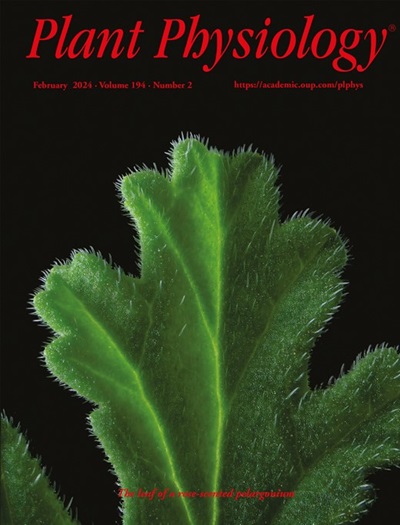Mechanisms behind the declining CO2 fertilization effects on plant growth and grain yield in soybean (Glycine max)
IF 6.9
1区 生物学
Q1 PLANT SCIENCES
引用次数: 0
Abstract
Although a global decline in the CO2 fertilization effect on vegetation productivity has recently been detected using Earth system models and satellite observations, the underlying ecological and physiological mechanisms remain poorly understood. In particular, the optimal atmospheric CO2 concentration for maximizing the CO2 fertilization effect is still unclear. In this study, we examined the optimal CO2 concentration for crop yield, plant growth, and leaf photosynthesis in soybean (Glycine max) plants utilizing environmental growth chambers to control CO2 concentration from 400 to 1600 μmol mol-1 with intervals of 200 μmol mol-1. Our findings indicate that the optimal atmospheric CO2 concentrations for crop yield and plant growth are between 1000 μmol mol-1 and 1200 μmol mol-1. Similarly, the optimal CO2 concentration for leaf photosynthesis is approximately 1200 μmol mol-1, at which point the CO2 fertilization effect reaches its maximum. Beyond this optimum, further increases in CO2 concentration not only reduce grain yield and plant biomass but also decrease leaf photosynthesis in soybeans. This demonstrates that high CO2 concentrations exceeding optimal levels have adverse effects on this critical grain crop. The physiological declines in the CO2 fertilization effect observed in soybean plants were modified by decreases in stomatal density and stomatal distribution regularity, biochemical and photochemical efficiency, and the expression level of photosynthetic genes at higher CO2 concentrations. Furthermore, this knowledge can contribute to a deeper understanding of the temporal dynamics of CO2 fertilization effects on terrestrial vegetation uptake and global carbon storage in the context of future climate change.CO2施肥降低对大豆植株生长和产量影响的机制
虽然最近利用地球系统模型和卫星观测发现二氧化碳施肥对植被生产力的影响在全球范围内下降,但其潜在的生态和生理机制仍然知之甚少。特别是,使CO2施肥效果最大化的最佳大气CO2浓度尚不清楚。本研究利用环境生长室将CO2浓度控制在400 ~ 1600 μmol mol-1,间隔为200 μmol mol-1,考察了CO2浓度对大豆(Glycine max)作物产量、植株生长和叶片光合作用的影响。结果表明,大气CO2浓度在1000 ~ 1200 μmol mol-1之间,有利于作物产量和植物生长。同样,叶片光合作用的最佳CO2浓度约为1200 μmol mol-1,此时CO2施肥效果最大。超过这一最佳浓度,二氧化碳浓度的进一步增加不仅会降低籽粒产量和植物生物量,还会降低大豆叶片的光合作用。这表明,超过最佳水平的高浓度二氧化碳对这种关键的粮食作物有不利影响。较高CO2浓度下大豆植株气孔密度和气孔分布规律、生化光化学效率以及光合基因表达水平的降低,对CO2施肥效应的生理下降进行了修正。此外,这些知识有助于在未来气候变化背景下更深入地了解CO2施肥对陆地植被吸收和全球碳储量影响的时间动态。
本文章由计算机程序翻译,如有差异,请以英文原文为准。
求助全文
约1分钟内获得全文
求助全文
来源期刊

Plant Physiology
生物-植物科学
CiteScore
12.20
自引率
5.40%
发文量
535
审稿时长
2.3 months
期刊介绍:
Plant Physiology® is a distinguished and highly respected journal with a rich history dating back to its establishment in 1926. It stands as a leading international publication in the field of plant biology, covering a comprehensive range of topics from the molecular and structural aspects of plant life to systems biology and ecophysiology. Recognized as the most highly cited journal in plant sciences, Plant Physiology® is a testament to its commitment to excellence and the dissemination of groundbreaking research.
As the official publication of the American Society of Plant Biologists, Plant Physiology® upholds rigorous peer-review standards, ensuring that the scientific community receives the highest quality research. The journal releases 12 issues annually, providing a steady stream of new findings and insights to its readership.
 求助内容:
求助内容: 应助结果提醒方式:
应助结果提醒方式:


